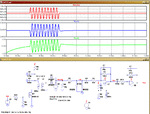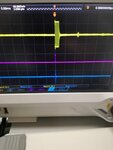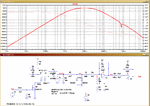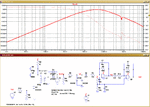reeraslan
Newbie level 4
Hi, I am working on Ultrasonic Transceivers for my range finder project. My main goal is to achieve this project with one sensor.
Before this, I've achieved range finding with Receiver / Transmitter Sensors separately. It worked well but as I said I need to finish this with transceiver sensor.
So, here is the my schematics that I draw for 1 sensor.

My driver circuits works fine. It generates around 100Vp-p. But the problem is there was no any echo signal coming through amplifier circuits. I tried to bring another ultrasonic transmitter sensor that generates 40khz 20Vp-p closer to this single transducer circuits. Still, there was no any signal after R13 & D2 protection stage on my osciloscope.
Here is the another info. Amplifier circuits also works fine. How do I know? When I stop generating high voltage from Driver circuit and remove the R13 & D2, I got very clear echo signals from the output of the 1st amplifier.
Here is the scope view

Blue: My Burst trigger signal. From Signal Generator ( LABEL : PWM )
Yellow : Bursted Voltage x100 ( TP14 )
Purple : 1st Amplifier output ( TP3 )
What am I doing wrong? Why can't I see any echo? Why my protection circuits ( R13 & D2 ) blocks the echo signals?
Thanks
Before this, I've achieved range finding with Receiver / Transmitter Sensors separately. It worked well but as I said I need to finish this with transceiver sensor.
So, here is the my schematics that I draw for 1 sensor.

My driver circuits works fine. It generates around 100Vp-p. But the problem is there was no any echo signal coming through amplifier circuits. I tried to bring another ultrasonic transmitter sensor that generates 40khz 20Vp-p closer to this single transducer circuits. Still, there was no any signal after R13 & D2 protection stage on my osciloscope.
Here is the another info. Amplifier circuits also works fine. How do I know? When I stop generating high voltage from Driver circuit and remove the R13 & D2, I got very clear echo signals from the output of the 1st amplifier.
Here is the scope view

Blue: My Burst trigger signal. From Signal Generator ( LABEL : PWM )
Yellow : Bursted Voltage x100 ( TP14 )
Purple : 1st Amplifier output ( TP3 )
What am I doing wrong? Why can't I see any echo? Why my protection circuits ( R13 & D2 ) blocks the echo signals?
Thanks





